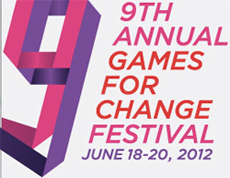 A couple of weeks ago, I was lucky enough to hear from “one of the most influential women in technology,” the creators of “Zombie Yoga,” aNASA research scientist, the founder of Atari AND Chuck E. Cheese, a classroom teacher working in Hong Kong, the White House’s “video game czar” and a bunch of 12 year old girls designing their own math games in Brooklyn, within the span of a couple of hours, without leaving a 2 block radius. How on earth did I manage to do this?
A couple of weeks ago, I was lucky enough to hear from “one of the most influential women in technology,” the creators of “Zombie Yoga,” aNASA research scientist, the founder of Atari AND Chuck E. Cheese, a classroom teacher working in Hong Kong, the White House’s “video game czar” and a bunch of 12 year old girls designing their own math games in Brooklyn, within the span of a couple of hours, without leaving a 2 block radius. How on earth did I manage to do this?
I went to G4C! The 9th annual Games for Change festival was held on June 18-20 in New York City. With attendees from all over the world, the festival was once again completely sold out this year bringing close to 1,000 game developers, educators, investors and academics to New York University’s campus with thousands more watching live streaming broadcasts online. As has become tradition, the second day of the festival was sponsored by the Games for Learning Institute (G4Li) and focused on the potential of games to inspire change across different learning environments. (And researchers from the Joan Ganz Cooney Center also had a chance to present their latest findings!)
After attending G4C last year, I wrote about festival discussions around the impending “Gamepocalypse” in which everything in our lives—from interactions on social networks, to our minute-to-minute physical activity, to our children’s daily experiences in the classroom would eventually be swallowed up by the trend of “gamification” and resemble a game of some sort. In 2011, there was a sense of cautionary excitement developing within the G4C community. While people were hopeful that well-designed games could make an impact, some were also wary of the possibility of ill-directed momentum and the misconception that games may be a cure-all to problems in education today.
This year, although speakers were still careful to suggest practical approaches to responsibly incorporating games into pedagogy, it seemed that the focus had shifted somewhat from “gamification” to “democratization” of games. Where conversations were no longer driven by the idea of “everything is a game” but rather the possibility that “everyone can play or make their own games.” This shift brought along with it a strong need to address contexts of interaction and empowerment through design.
Dr. Jim Gee, author of Good Video Games + Good Learning, reiterated the importance of context with an excellent keynote in which he emphasized the importance of not only the design of games, but also of the social interactions and environments that make up major parts of the gameplay experience. While the phenomenon of “gamification” may be a useful means of motivating players and directing the attention of learners, those in the G4C community need to be mindful of the design of various game components and what the goals and needs of specific players are in context. Gee suggested that, especially within the context of good learning through good games, standards need to be indigenous to the people playing and the tasks at hand. In other words, in line with theories of learning, games should be utilized to help players develop situated understandings of their world.
In the festival closing keynote, Lucy Bradshaw, the general manager of Maxis and a major part of the reason that the world has the SimCity, the Sims, Spore, and Harry Potter franchises, really brought the idea of the “democratization” of games to light with an overview of the current landscape of gaming. Lucy suggested that the democratization of games has come out of trends showing that over the last few years we’ve discovered that a couple of things are now possible:
1) Games can come in many different forms because of the mobile and social network boom along with technology developments like unity and flash programming capabilities, along with the digitization age for moving images.
2) Anyone can make and distribute games because of the app market and platforms like iTunes and Facebook.
And I would also add to Lucy’s points:
3) “Gamers” come in many different forms – non-traditional gamers,women, parents, social gamers, casual gamers, kids of all ages, even… you
With all of these developments and more innovation on the horizon, gaming can be something personal, social, transformative and impactful for everyone. To end with Lucy Bradshaw’s final sentiment, “the current world and opportunity set is a fascinating place to be in. So, play!”




